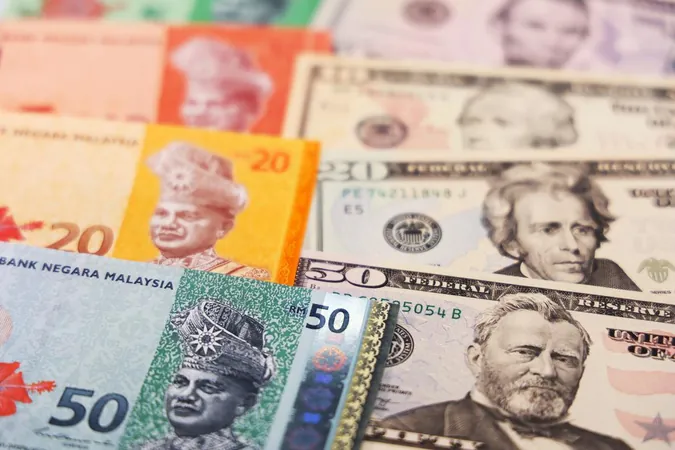
Ringgit Set for a Comeback: Analysts Predict Further Gains Amid Rate Cuts
2025-08-18
Author: Arjun
The Ringgit Rally Could Be Just Beginning
The Malaysian ringgit is gearing up for a significant rebound, potentially reaching its strongest position against the US dollar in nearly a year. Analysts are optimistic as they anticipate a dovish stance from the central bank and supportive fiscal policies enhancing market sentiment.
Predictions for Currency Appreciation
Experts forecast that the ringgit could soar to 4.15 per US dollar by the fourth quarter, buoyed by additional easing from the central bank, according to OCBC Bank. Meanwhile, Maybank projects a slightly more optimistic rate of 4.10 by December. MUFG Bank also sees the ringgit appreciating by 1.5% from its current levels, aided by a favorable US tariff agreement that would enhance Malaysia’s export competitiveness.
Current Exchange Rates and Recent Performance
As of August 18, the ringgit was valued at 4.2220 against the US dollar, reflecting a robust 5.8% increase against the greenback so far this year. In contrast, it stood at 3.2919 against the Singapore dollar, marking a slight decline of 0.6% in 2025.
Inflation Data and Rate Cut Speculation
The ringgit's rally has encountered some obstacles, but upcoming inflation reports may reignite hopes for rate cuts from Bank Negara Malaysia (BNM), which would encourage foreign bond investments. While generally, looser monetary policy might weaken currencies, a potential rate cut from the Federal Reserve could offset any sell-off against the US dollar.
Market Sentiment and Structural Reforms
Analysts are increasingly optimistic about the prospects of lower domestic rates, which would play a pivotal role in boosting currency sentiment. Christopher Wong, an executive director at OCBC, emphasized that the ringgit’s strength also hinges on continued foreign capital inflows and the government’s steadfast commitment to fiscal reforms.
Record Bond Inflows and Economic Outlook
A record influx of US$4.3 billion into Malaysian bonds during the second quarter has shown global confidence in Malaysia’s economic outlook, especially following a recent 25-basis-point rate cut by BNM. The anticipation of more lenient US monetary policies and a weaker dollar further fuels demand for Malaysian sovereign debt.
Potential Risks Despite Positive Developments
Despite favorable tariff reductions from the US, analysts warning about ongoing global trade tensions stress that these could still negatively impact the ringgit. Matthew Ryan from Ebury Partners highlighted that prolonged trade uncertainty could lead to detrimental effects on Malaysia’s economy and cause a more substantial drop in the currency's value.
Strategic Plans and Future Growth
Prime Minister Anwar Ibrahim has introduced a forward-thinking five-year growth plan, aiming to boost the economy through 2030. This includes a one-time RM2.8 billion stimulus package featuring cash handouts and reduced fuel prices, along with efforts to curb excessive spending by cutting diesel subsidies. Given these strategies and manageable inflation rates, there is optimism regarding further easing of BNM's policy, providing essential support for the ringgit’s stability.
Conclusions: A Steady Path Ahead
Key decisions surrounding government-led structural reforms present a promising outlook for the ringgit, enhancing productivity and maintaining fiscal discipline. With these catalysts, analysts like Lloyd Chan of MUFG believe the currency could well reach 4.15 by year-end, reinforcing the ringgit's potential as a strong player in the foreign exchange arena.



 Brasil (PT)
Brasil (PT)
 Canada (EN)
Canada (EN)
 Chile (ES)
Chile (ES)
 Česko (CS)
Česko (CS)
 대한민국 (KO)
대한민국 (KO)
 España (ES)
España (ES)
 France (FR)
France (FR)
 Hong Kong (EN)
Hong Kong (EN)
 Italia (IT)
Italia (IT)
 日本 (JA)
日本 (JA)
 Magyarország (HU)
Magyarország (HU)
 Norge (NO)
Norge (NO)
 Polska (PL)
Polska (PL)
 Schweiz (DE)
Schweiz (DE)
 Singapore (EN)
Singapore (EN)
 Sverige (SV)
Sverige (SV)
 Suomi (FI)
Suomi (FI)
 Türkiye (TR)
Türkiye (TR)
 الإمارات العربية المتحدة (AR)
الإمارات العربية المتحدة (AR)